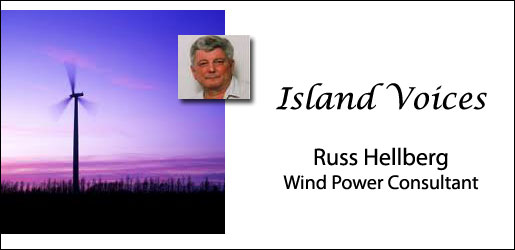Russ Hellberg December 2009
Current Article ∙ Archive ∙ Back to Island Voices
December 2009:
A wind farm near Fort Macleod, Alta. Three new wind-power projects slated for B.C. came closer to fruition this week. Photograph by: Handout photo, Vancouver Sun files
B.C.’s wind power sector catches updraft with three major projects
BY SCOTT SIMPSON, VANCOUVER SUN / DECEMBER 11, 2009
VANCOUVER — British Columbia’s burgeoning green electricity sector got a triple-jolt of good news this week.
One stalled project has new owners with solid financial resources and two others vying for contracts with BC Hydro got major credibility boosts from the provincial government.
Plutonic Power and GE Energy Financial Services announced Friday that construction will resume this spring on Phase 1 of the Dokie wind farm project, which they acquired after the former proponent went into creditor protection.
On Thursday, two other large and ambitious wind power projects — NaiKun and Thunder Mountain — reached a milestone step when they received environmental approvals from the provincial government.
Phase 1 of the Plutonic-GE Dokie project involves a cluster of 48 80-metre turbine towers on a ridge near Chetwynd in northeast B.C.
Former proponent EarthFirst Canada had five turbines and 11 concrete pads on-site when a financing partner pulled out of the 144-megawatt project and left it without the financial resources to proceed.
EarthFirst had already secured an energy purchase agreement with BC Hydro and Dokie was on target to be B.C.’s first-ever commercial wind power project until the global economic meltdown of 2008 cause its financing to collapse.
Plutonic and GE announced that the project will resume site preparation work in January and commence construction in earnest this spring with the expectation of reaching commercial operation by early 2011.
“We had an agreement in principle last June,” Plutonic vice-chair and CEO Donald McInnes said in an interview. “What we’ve now done is completely close the transaction.
“The financing is fully in place — both the debt and equity. We have a fixed-price construction contract. We have an amended and transferred energy purchase agreement from BC Hydro to the GE-Plutonic partnership and we are proceeding full bore.
“We have the requisite people on a team who are going to oversee the construction here, and advance very quickly in operations.”
McInnes said the project should be “fully on line” by the end of 2010 or early 2011.
A day earlier NaiKun Wind Energy Group was certified by B.C.’s environmental assessment office for a 396 megawatt offshore wind project near Islands Haida Gwaii (formerly Queen Charlotte Islands).
Aeolis Wind was approved by the same office for its Thunder Mountain Wind project near Tumbler Ridge.
NaiKun is still awaiting the outcome of a federal environmental screening process while Thunder Mountain is awaiting a federal determination on whether or not it will be subject to the Canadian Environmental Assessment Act.
Both projects are currently in negotiation with BC Hydro for inclusion on the list of companies that will be awarded energy purchase agreements under Hydro’s 2008 clean call and will require a favourable verdict from the feds as part of those negotiations.
Hydro is seeking 5,000 gigawatt hours of electricity and is currently in negotiation with proponents of 47 projects which offer more than twice that amount of power.
Environment Minister Barry Tenner, who co-announced the B.C. approvals with Energy Minister Blair Lekstrom, said he was particularly struck by the size of the two projects.
“Out of my own curiosity I wondered how these would rank compared to other wind power projects in Canada,” Penner said.
“In the case of Thunder Mountain it would be almost 50 per cent larger than Canada’s next largest wind project, which is at Wolf Island near Kingston. That one I think is 190 megawatts all in.
“Thunder Mountain is proposed at 320 at this stage, and NaiKun would be even more than that.”
NaiKun president and CEO Paul Taylor echoed Penner’s observation.
“If you take this project along with the Thunder Mountain project that was also approved yesterday, the two combined will produce enough electricity for about 90 per cent of the city of Vancouver’s needs — the homes in the city of Vancouver. So these are pretty significant projects for British Columbia.”
NaiKun is partnering with the Council of the Haida Nation. Aeolis Wind previously acted as developer of B.C.’s first, and to date only, commercial wind park which is located at Bear Mountain near Dawson Creek.
It sold its interest to Bear Mountain partner AltaGas.
At Thunder Mountain, the Victoria-based company envisions itself as owner-operator and believes northeast B.C. wind resources are large enough to foster development of a manufacturing sector in support of the industry there.
“There is such an incredible wind resource in the Peace Region,” Aeolis external relations director TJ Schur said. “The Thunder Mountain project has upwards of 1,000 megawatts potential, alone. It’s a number of hilltops. We have been permitted for 320.”
Colleen Brown, director of projects and planning for Aeolis, said the first phase of Thunder Mountain encompasses two parallel ridges.
“It’s an excellent example of the kind of wind that’s found up in the northeastern quadrant of B.C., which is where the majority of our interests have focused.
“It’s unidirectional. It’s focused. It’s very consistent, with a little bit of seasonal variation, but consistent enough in the years that we’ve been mapping these sites that it gives us confidence we’ve got a world-class project in terms of wind ratings that are unlike those usually seen in other parts of the world, let alone the country.”
© Copyright (c) The Vancouver Sun



